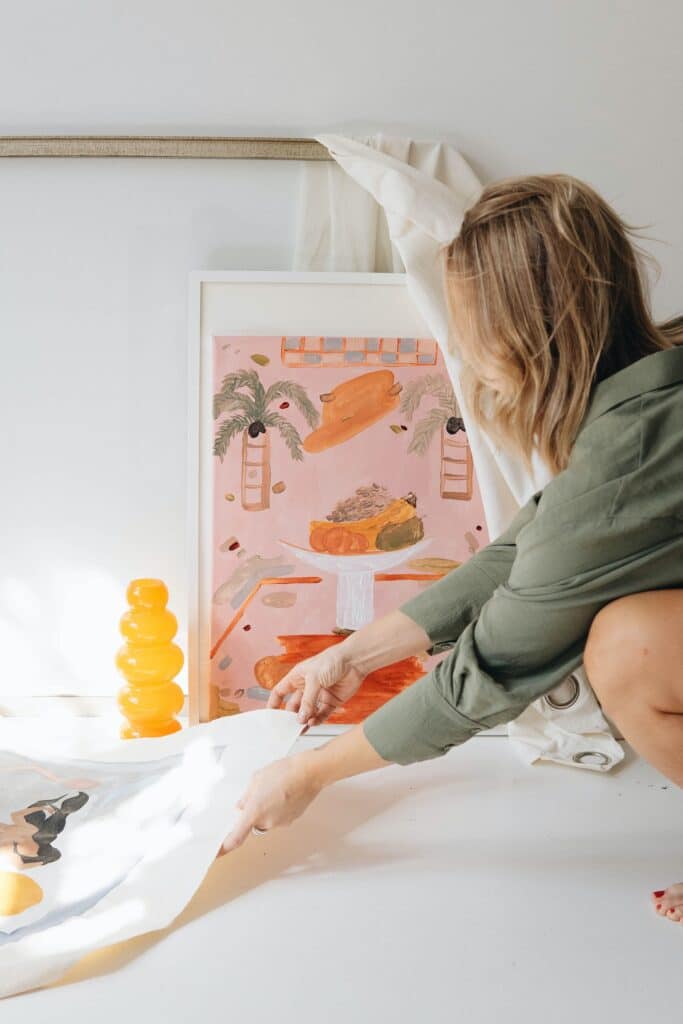Wenn du noch nie versucht hast, deine Werke auf einem lokalen Kunstmarkt zu verkaufen, verpasst du vielleicht eine großartige Möglichkeit, mit deiner kreativen Arbeit ein zusätzliches Einkommen zu erzielen, neue Kontakte zu knüpfen und deine Marke bekannt zu machen.
Bevor wir weiter eintauchen, ist es wichtig zu wissen, dass nicht jeder Kunstmarkt für deine Arbeit geeignet ist - und das ist okay! Es gibt für jede Nische, jede Gemeinschaft und jeden Feiertag einen Kunstmarkt. Deshalb ist es wichtiger, dass du dir die Zeit nimmst, um herauszufinden, welche Kunstmärkte für dich geeignet sind, als dich auf den ersten großen Markt zu stürzen, den du siehst. Da es so viele gibt, kann es schwierig sein, die Liste einzugrenzen, also solltest du dich auf ein paar wichtige Punkte konzentrieren.
Auswahl der Drucke
Wie viele Arbeiten du mitbringst und welche Drucke du auswählst, hängt von dem Markt ab, an dem du teilnimmst. Im Allgemeinen wirst du wahrscheinlich nicht von jedem Kunstwerk in deinem Portfolio Abzüge mitbringen. Stattdessen solltest du deine Drucke so auswählen, dass du den besten Ertrag aus deiner Investition erzielst.
Verstehe dein Zielpublikum
Je nach Kunstmarkt, an dem du teilnimmst, wirst du wahrscheinlich eine Reihe von Drucken mitbringen, die darauf zugeschnitten sind, wer wahrscheinlich teilnimmt. Wenn du zum Beispiel an einem Weihnachtsmarkt teilnimmst, solltest du vielleicht Drucke mitbringen, die sich um die Feiertage drehen, oder qualitativ hochwertige Drucke mit attraktiver Verpackung, die sich gut als Weihnachtsgeschenk eignen. Wenn du an einem Pride Art Market teilnimmst, werden Drucke mit einem inklusiven, queeren Schwerpunkt gut ankommen.
Nicht jede Art von Arbeit verkauft sich auf jeder Art von Markt gut, also denke daran, wer daran teilnimmt - du würdest wahrscheinlich nicht auf einer Comic-Convention auftauchen wollen, um Naturbilder zu verkaufen, oder auf einem Kunstmarkt in einem Gemeindezentrum, um Boudoir zu verkaufen.
Auf Qualität und Präsentation kommt es an
Einige Märkte verlangen qualitativ hochwertigere Drucke als andere, während andere Märkte mehr Sorgfalt bei der Präsentation deiner Arbeit verlangen. Je nach Art des Marktes, an dem du teilnimmst, kann es mehr oder weniger notwendig sein, sich auf die Qualität deiner Abzüge zu konzentrieren.
Generell gilt: Wenn du auf einem Markt verkaufst, der Wert auf limitierte Auflagen, Galeriequalität oder Unikate legt, solltest du deine Werke professionell auf hochwertigem Material drucken lassen oder sogar Originale verkaufen. Es kann auch notwendig sein, dein Werk zu rahmen und zu signieren und eine geeignete Verpackung bereitzuhalten, damit der Druck nicht beschädigt wird.
Wenn du auf einem Markt verkaufst, bei dem es auf ein hohes Einkaufsvolumen ankommt - z. B. auf Comic-Conventions, Stolzmärkten und kleinen Künstlermärkten - solltest du weniger für die Materialqualität deiner Arbeit ausgeben. Stapeldruck und Plastikhüllen sind hier üblicher, ebenso wie kleinere Druckformate, und die Einrahmung ist weit weniger üblich. Du wirst eher ein größeres Volumen an günstigen bis mittelpreisigen Drucken haben wollen als sehr teure limitierte Auflagen.
Preisgestaltung für deine Abzüge
Die Preisgestaltung kann für viele Kreative und auch für potenzielle Kunden ein Knackpunkt sein. Die richtige Balance zwischen Erschwinglichkeit und Rentabilität hängt davon ab, welche Art von Druckerzeugnissen du verkaufst und in welchem Markt du tätig bist.
Überlege dir zunächst die Gesamtkosten, die für die Erstellung deiner Drucke anfallen. Berücksichtige die Kosten für den Druck, die Verpackung, die Zeit, die du für die Herstellung des Drucks gebraucht hast, alle Werbematerialien, die du mit dem Druck verpackst, und die Gemeinkosten, die mit der Teilnahme am Markt verbunden sind. Die Ermittlung dieser Kosten ist ein guter Ausgangspunkt für die Preisgestaltung und kann dir dabei helfen, zu vermeiden, dass du in die Falle tappst, deine Arbeit unterzubewerten und unter Wert anzubieten.
Abgesehen von diesen Kosten solltest du dir auch Gedanken über die Art der Arbeiten machen, die von anderen Künstlern auf dem Markt, an dem du teilnimmst, verkauft werden. Sind kleine Drucke beliebter als große Drucke? Bevorzugt der Markt teurere Unikate? Sind Mengenrabatte üblich? Dein Können und deine Gemeinkosten spielen eine Rolle, aber auch die üblichen Preise anderer Künstler/innen sind wichtig.
Um dir die Recherche zu erleichtern, solltest du ein paar lokale Kunstmärkte besuchen, bevor du dich auf deine Preise festlegst. So bist du besser vorbereitet, wenn die Zeit für die Teilnahme an deinem eigenen Markt gekommen ist.

Auf dem Kunstmarkt
Du hast also deine Preise festgelegt, weißt, wie viel Arbeit du mitbringen musst, und gehst zu den letzten Vorbereitungen über. Aber jetzt kommt der schwierigste Teil: Du musst dir überlegen, wie du dich auf dem Kunstmarkt präsentieren und bewerben willst.
Marketing und Werbung
Der Verkaufsabschluss ist nur die Hälfte der Arbeit, die für einen erfolgreichen Marktauftritt nötig ist. Die meisten Menschen, die deinen Stand besuchen, werden wahrscheinlich weiterziehen, ohne etwas zu kaufen. Auf einem Markt mit vielen Ständen können potenzielle Kunden wählerisch sein, was ihr Geld angeht. Das kann für Erstverkäufer/innen entmutigend sein, aber es ist wichtig zu wissen, dass viele Besucher/innen von Kunstmärkten kommen, um sich umzuschauen, mit der Absicht, später zu kaufen.
Aus diesem Grund solltest du eine Art von Werbematerial dabei haben. Du kannst die folgenden Dinge in Betracht ziehen:
- Visitenkarten
- Coupons
- Postkarten und Lesezeichen
- Aufkleber
Die oben genannten Artikel sind alle klein und relativ kostengünstig in Massenproduktion herzustellen. Alle diese Artikel sollten mit deinen sozialen Medien oder deiner Website versehen sein und helfen potenziellen Kunden, dich nach dem Markt zu finden.
Aufbau deines Standes
Wenn du es auf den Markt geschafft hast, solltest du einen klaren Plan haben, wie du deinen Stand aufbaust und dabei Dinge wie den Standort, die Stände und die Art der Abwicklung berücksichtigen.
Standort des Standes
Auf den meisten Märkten hast du zwei Hauptoptionen, was die Art und den Standort deines Standes angeht: Eckstände und normale Stände. Die meisten regulären Stände auf Märkten und Kongressen bestehen aus einem 1,80 m langen Tisch und Stühlen. Eine schlichte Tischschürze kann in deinem Stand enthalten sein, muss aber nicht.
Eckstände können ein bisschen vielfältiger sein. Sie können zwei zwei Meter lange Tische enthalten oder nur eine Bodenfläche, damit du den Raum interaktiv einrichten kannst. Eckstände gelten auch als Top-Standorte, weil sie eher Kunden anziehen.
Display-Ständer
Die Vertikalität ist wichtig und wird von Erstverkäufern oft übersehen. Es ist sehr wahrscheinlich, dass die Verkäufer/innen um dich herum eine Art vertikale Struktur haben, an der sie ihre Ware befestigen. Wenn du ohne solche Strukturen auftrittst, kann das dazu führen, dass dein Stand von potenziellen Käufern übersehen wird.
Wenn du zum ersten Mal auf einen Kunstmarkt gehst, brauchst du wahrscheinlich nichts Ausgefallenes. Aufbewahrungswürfel aus Draht bestehen aus gerasterten Drahtquadraten, die zusammengesteckt werden und Würfel bilden. Sie eignen sich hervorragend für Marktstände, weil sie leicht, aber stabil sind und sich individuell zusammenstellen lassen. Du kannst Drucke, Lesezeichen, Werbematerialien und andere kleine Gegenstände an den Drahtwürfeln aufhängen. Außerdem sind sie leicht zu dekorieren!
Abwicklung von Transaktionen
Nach all der mühsamen Arbeit beim Aufbau deines Standes ist die Abwicklung der Transaktionen ein einfacher Schritt. Du musst dafür sorgen, dass du die Transaktionen einfach protokollieren kannst, dass du genügend Wechselgeld hast, um Barkäufe zu bearbeiten, und dass du Kreditkarten akzeptieren kannst. Hierfür kannst du einen Transaktionsverarbeitungsdienst wie Square oder Stripe in Betracht ziehen.
Mit Kunden in Kontakt treten
Wenn du mit Kunden in Kontakt trittst, solltest du freundlich und hilfsbereit sein, aber nicht zu sehr. Die meisten Besucher/innen auf Kunstmärkten sind zum Stöbern da, und das Letzte, was du tun willst, ist, potenzielle Käufer/innen zu vergraulen, indem du ihnen zu viel verkaufst.
Wenn du auf einem Kunstmarkt arbeitest, ist es eine gute Faustregel, Hallo zu sagen, dich vorzustellen und potenzielle Käufer/innen wissen zu lassen, dass du da bist, um ihnen zu helfen, wenn sie Fragen haben. Wenn du bemerkst, dass potenzielle Käufer/innen bei einem bestimmten Produkt verweilen oder es anstarren, kannst du eingreifen und weitere Informationen anbieten.
Eine weitere wichtige Sache, die du in Betracht ziehen solltest, ist das Geschichtenerzählen als Teil deiner Interaktion mit potenziellen Käufern. Wenn ein potenzieller Käufer ein Werk längere Zeit betrachtet oder um weitere Informationen bittet, hast du die Gelegenheit, einen Einblick in deine Vision als Künstler und deinen kreativen Prozess zu geben. Das kann das Interesse und die Investition in deine Arbeit steigern.
Wenn Käufer und potenzielle Käufer deinen Stand verlassen, solltest du proaktiv sein und eine Visitenkarte oder anderes Werbematerial anbieten. Das ist eine gute Möglichkeit, Kunden zu binden und dauerhafte Beziehungen aufzubauen.

Nachdem der Markt
Der Markt ist vorbei, du hast deine Stände abgebaut, deine Sachen gepackt und alles nach Hause gebracht. Jetzt bist du wahrscheinlich erschöpft und bereit, bis morgen zu schlafen. Wenn du das getan hast, ist es eine gute Idee, den Markt Revue passieren zu lassen.
Kunstmärkte sind eine Lernerfahrung. Nur wenige machen beim ersten Mal einen herausragenden Job, aber jeder wird etwas daraus lernen. Hoffentlich hast du nach deinem ersten Kunstmarkt eine Menge darüber gelernt, was funktioniert hat und was nicht, und wie du dich beim nächsten Mal verbessern kannst.
Das erste, was du analysieren solltest, sind die Umsätze und Ausgaben. Es ist wichtig, dass du objektiv betrachtest, wie gut du insgesamt abgeschnitten hast, einschließlich der Effektivität deiner Preisgestaltung und der Menge der verkauften Produkte. Das kann beängstigend sein, aber es ist ein notwendiger Schritt, um herauszufinden, wie du dich verbessern kannst.
Wenn du dir deine Verkäufe angesehen und den Nettogewinn berechnet hast, den du während des Kunstmarktes erzielt hast, ist es eine gute Idee, zu überprüfen, ob die Dinge deinen Erwartungen entsprochen haben. Hast du die richtigen Dinge vorbereitet? Gab es etwas, das du übersehen hast? Sind einige Dinge anders gelaufen, als du erwartet hast? Vielleicht hat sich ein bestimmtes Stück besonders gut verkauft, während etwas, von dem du erwartet hast, dass es sich gut verkauft, schlecht gelaufen ist.
Wie auch immer, wenn du deine Verkäufe aus einer analytischen und kritischen Perspektive betrachtest, wirst du mit dem Wissen ausgestattet, das du brauchst, um dich beim nächsten Mal besser vorzubereiten.
Kunstmärkte können eine überwältigende Erfahrung sein. Letztendlich können sie aber auch eine wunderbare Möglichkeit sein, dein Geschäft zu vermarkten, dich in deiner kreativen Gemeinschaft zu vernetzen und in kurzer Zeit ein Einkommen zu erzielen.
Denk daran, dass dein erster Versuch nie perfekt sein wird! Aber wir hoffen, dass du, egal für welche Art von Markt du dich entscheidest, jetzt ein bisschen mehr Wissen hast, um zu wissen, was du beachten musst.













